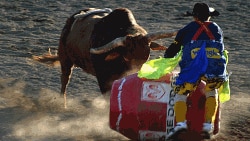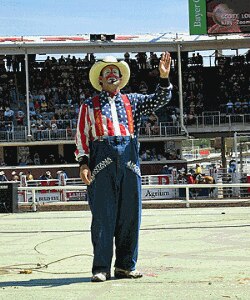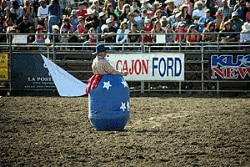In small towns across the American West, a favorite form of entertainment is the rodeo. It's a show and competition in which modern-day cowboys ride bucking horses and ornery bulls. Cowgirls in colorful outfits race on horseback around barrels placed throughout the arena. Calves are roped and tied in a matter of seconds.
And there's a special brand of rodeo performers right in the middle of the action. They're bullfighters, lifesavers and comedians, all in one.
Clowning around distracts bulls after riders fall
When a rider charges out of the chute atop a mean and agitated bucking bull, he can easily get into deadly trouble. That's where two cowboys in clown outfits, standing in the ring beside the chute, fit into the rodeo scene. Like the competitors, they usually have on broad-brimmed hats, boots and blue jeans.
But they also wear gaudy shirts, oversized bright-red neckerchiefs tied to their waists, and sometimes funny face paint. Between events, just as in a circus, rodeo clowns act silly to entertain children in the audience.
But their most important job is to whistle, shout, flap their arms and run about crazily to turn the attention of an unhappy, 500-kilogram animal with sharp horns away from a fallen rider. It's better to have the bull chasing nimble clowns than goring an injured bull rider.
Rodeo clowns earn respect and a good income
There was a time when many clowns were washed-up rodeo competitors, slowed by age, injury or overuse of alcohol. But rodeo clowning has become such a valued specialty that most clowns are as young and vigorous as the competitors. Many are almost tiny, like the jockeys who ride thoroughbred horses.
The clowns can make a handsome living without ever getting on a horse or bull. Rodeos even developed an event just for them. It's called bullfighting, in which clowns earn points, prize money and lots of laughs by artfully evading grouchy bulls.
When rodeo clowns are too crippled, or too old, to work the ring any longer, most of these men – and almost all of them are male – find work anywhere they can to stay around a rodeo.
Read more of Ted's personal reflections and stories from the road on his blog, Ted Landphair's America.







